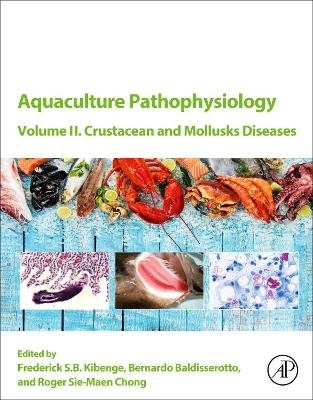
Aquaculture Pathophysiology
Academic Press Inc (Verlag)
978-0-323-95434-1 (ISBN)
This comprehensive resource is ideal for researchers, teachers, students, diagnostic laboratory scientists, aquaculture technicians, and farmers who need to be competent across both finfish and shellfish health issues.
Dr. Frederick Kibenge is Professor of Virology at the Atlantic Veterinary College, University of Prince Edward Island. He obtained his BVM from Makerere University and his PhD from Murdoch University, and he is the former Chairman of the Department of Pathology and Microbiology at the Atlantic Veterinary College. Dr. Kibenge has more than 30 years of experience investigating animal viruses and the biology of viral pathogens. His research focuses on understanding the mechanisms of virus virulence to improve on methods of virus detection and control. Bernardo Baldisserotto is a full professor in the Department of Physiology and Pharmacology at the Federal University of Santa Maria. He has published five books on fish physiology and fish culture, and has organized and participated in numerous other books and journal publications. Dr. Baldisserotto is editor-in-chief for the Physiology and Biochemistry section of Neotropical Ichthyology and associate editor of Fishes and the Journal of the World Aquaculture Society. Dr. Roger Sie-Maen CHONG is a veterinary specialist in Australia and the United Kingdom (UK), with expertise in fish and shellfish pathology as applied to the health and biosecurity of aquacultured species. He is officially registered as a specialist by the Queensland Board of Veterinary Surgeons for Veterinary Aquatic Animal Health (Australia) and by the Royal College of Veterinary Surgeons for Fish Health and Production (UK). He is also a certified Fish Pathologist recognized by the Fish Health Section of the American Fisheries Society. Dr. Chong has worked in Hong Kong with the Department of Agriculture, Fisheries & Conservation, in Queensland with the Biosecurity Queensland and is presently a research fish pathologist with the Australian Commonwealth Scientific and Industrial Research Organization (CSIRO).
SECTION I. CRUSTACEAN DISEASES 1. Crustacean laboratory methods; 2. Crustacean Disease Terminology; 3. Crustacean immunology
SECTION II. VIRAL DISEASES 4. Covert Mortality Disease; 5. Crab viral diseases; 6. Crayfish viral diseases; 7. Infectious hypodermal and hematopoeitic necrosis virus disease; 8. Infectious myonecrosis virus disease; 9. Lobster Panulirus argus virus (PaV1) disease; 10. Monodon slow growth syndrome; 11. Spherical baculovirosis; 12. Shrimp Hemocyte Iridescent Virus (Decapod Iridescent Virus 1); 13. Taura syndrome virus disease; 14. Tetrahedral baculovirosis; 15. White spot syndrome virus disease of shrimp; 16. WSSV in wild mudcrabs; 17. White tail disease; 18. Yellow head virus disease
SECTION III. BACTERIAL DISEASES 19. Acute hepatopancreatic necrosis disease; 20. Crab larval luminescent vibriosis; 21. Chitinolytic Shell Disease; 22. Lobster Gaffkemia; 23. Mitten crab tremor disease; 24. Necrotising hepatopancreatitis (Hepatobacter penaei); 25. Shrimp mycobacteriosis; 26. Shrimp rickettsial disease; 27. Shrimp vibriosis
SECTION IV. PARASITIC DISEASES 28. Bitter crab disease (Hematodinium); 29. Crab ciliate disease (Mesanophrys); 30. Grey crab disease (Paramoeba perniciosa); 31. Lobster bumper car disease (Anophryoides haemophila); 32. Mud crab Octolasmis spp. barnacles; 33. Shrimp fouling organisms; 34. Shrimp gregarines (White Feces Syndrome); 35. Shrimp haplosporidiosis
SECTION V. FUNGAL DISEASES 36. Cotton shrimp; 37. Crab Lagenidium disease; 38. Crayfish plague; 39. Crayfish Thelohania disease; 40. Enterozytozoon hepatopenaei microsporidiosis; 41. Lobster Haliphthoros disease; 42. Shrimp Fusarium disease; 43. Shrimp larval mycosis
SECTION VI. NUTRITIONAL DISEASES 44. Vitamin deficiencies in shrimp; 45. Soft shell and blue shell syndrome in shrimp; 46. Crab larval mortality and nutrition
SECTION VII. ENVIRONMENTAL DISEASES 47. Black gill disease in shrimp; 48. Endocrine disruption in crustacea; 49. Pollutant toxicoses – pesticides, heavy metals, industrial organic chemicals in crustaceans; 50. Shell diseases; 51. Lobster Epizootic Shell Disease
SECTION VIII. GENETIC AND NEOPLASTIC DISEASES 52. Abdominal segment deformity in shrimp; 53. Inbreeding of shrimp, crabs and lobsters; 54. Neoplasia in decapod crustacea
SECTION IX. MOLLUSK DISEASES 55. Molluscan Disease Laboratory Methods; 56. Molluscan Disease Terminology; 57. Mollusk immunology; 58. Pearl Oyster Diseases; 59. General Pathology and Diseases of Abalone
SECTION X. VIRAL DISEASES 60. Abalone herpesvirus; 61. Diseases of viral origin in clams, mussels and scallops; 62. Hemocytic infection virus disease (oysters); 63. Ostreid Herpesvirus Disease; 64. Oyster velar virus disease; 65. Viral gametocytic hypertrophy (oysters)
SECTION XI. BACTERIAL DISEASES 66. Vibriosis of Larval Scallops; 67. Nocardiosis in Oysters; 68. Scallop Chlamydia and Rickettsia-like organisms; 69. Vibriosis in green mussels
SECTION XII. PARASITIC DISEASES 70. Bonamiasis; 71. Molluscan haplosporidiosis; 72. Kidney coccidiosis (scallop, abalone, mussels, oysters, clams); 73. Marteiliosis; 74. Mikrocytosis mackini; 75. Nematopsis protozoan infections; 76. Perkinsosis; 77. Shell boring polychaetes (Mudworms) and sponges affecting oysters, scallops and abalone.
SECTION XIII. FUNGAL AND NUTRITIONAL DISEASES 78. Ostracoblade implexa disease (oysters); 79. Sirolpidium zoophthorum larval mycosis; 80. Microsporidiosis (Steinhausia mytilovum); 81. Hatchery Nutritional Conditions of Mollusks
SECTION XIV. ENVIRONMENTAL DISEASES 82. Pollutant toxicoses of mollusks; 83. Endocrine disruption in mollusks; 84. Ocean acidification
SECTION XV. GENETIC AND NEOPLASTIC DISEASES 85. Inbreeding, genetic selection and manipulation of oysters; 86. Hemocytic neoplasia in mollusks
| Erscheinungsdatum | 26.08.2022 |
|---|---|
| Verlagsort | Oxford |
| Sprache | englisch |
| Maße | 216 x 276 mm |
| Gewicht | 450 g |
| Themenwelt | Technik ► Lebensmitteltechnologie |
| ISBN-10 | 0-323-95434-0 / 0323954340 |
| ISBN-13 | 978-0-323-95434-1 / 9780323954341 |
| Zustand | Neuware |
| Haben Sie eine Frage zum Produkt? |
aus dem Bereich


